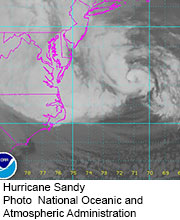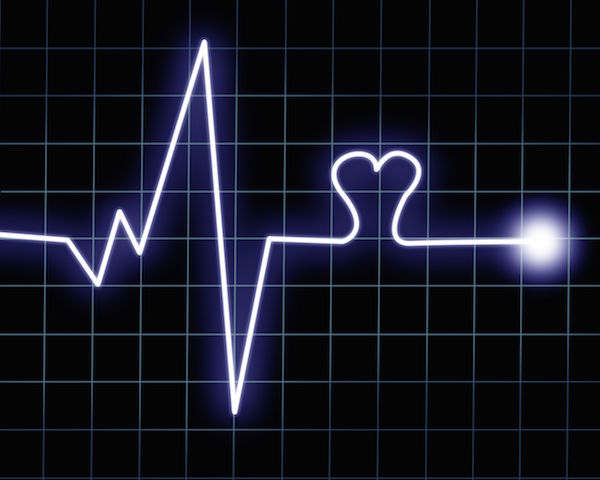
MONDAY, Oct. 29 (HealthDay News) — As Hurricane Sandy sent strong storm surges into the coasts of New Jersey, New York and Delaware Monday morning, federal officials warned that more than 50 million people could face historic flooding and damaging winds that make widespread power outages a certainty.
As of 5 a.m. Monday morning, Sandy was churning in the ocean just 385 miles southeast of New York City, and beginning to make a left turn toward land. Experts say an 11-foot wall of water could engulf parts of lower Manhattan and nearby coastal areas, Fox News reported. The massive storm intensified overnight, with winds now exceeding 95 miles per hour at times. Those ferocious winds are expected to be felt a whopping 175 miles from Sandy’s center as she plows through New Jersey and upstate New York.
Forecasters at the National Hurricane Service predict the storm will make landfall along the New Jersey coast on Monday between 5 p.m. and 7 p.m. Eastern, ABC News reported. Experts said Sandy’s impact might even be felt as far away as the Great Lakes, as she joins forces with a winter storm and a cold front.
“We’re looking at impact of greater than 50 to 60 million people,” Louis Uccellini, head of environmental prediction for the U.S. National Oceanic and Atmospheric Administration, told Fox News.
Major cities in Sandy’s path shut down public transit systems and closed schools, and federal government offices were also shuttered on Monday. More than 7,200 flights in the Northeast corridor have been cancelled, and airports in those cities are expected to close Monday afternoon, according to Fox News.
Amtrak stopped all train service between Washington, D.C., and New York City on Monday, and states of emergency were declared Sunday in Virginia, Maryland, Washington, D.C., Pennsylvania, New Jersey, New York, Connecticut and Maine, the Washington Post reported.
Meanwhile, millions of residents in the Mid-Atlantic and the Northeast have been advised to be prepared in every way possible for the inevitable, and massive, damage Sandy will leave behind.
“The time for preparing and talking is about over,” U.S. Federal Emergency Management Administrator Craig Fugate told Fox News. “People need to be acting now.”
For starters, be stocked up on prescription medicines, special medical supplies, nonperishable foods — baby formula and pet foods, too — and emergency essentials in case the storm knocks out power in your region or makes travel impossible.
“Have a family communications plan as well, in case you get separated during the storm,” said Dr. Robert Glatter, an emergency medicine physician at Lenox Hill Hospital in New York City. Decide where to meet and how you will remain in contact.
“Be prepared to be self-sufficient for one to five days without access to grocery stores,” Glatter added.
David Bernard, chief meteorologist for CBS News’ Miami station, said a confluence of events could potentially turn this storm into one rivaling the 1991 Halloween Nor’easter, which killed 13 people and became the subject of the best-selling book and movie “The Perfect Storm.”
Referring to Sandy, Bernard said, “That’s a lot of warm air, a lot of heat, a lot of energy and of course we’re deep into fall now and we have an unusual strong jet stream dip with winter-like cold air, and you put those two things together, that’s the possibility that is on the weather maps right now, and that could lead to a powerhouse low pressure forming Sunday and Monday.”
In other words, “it’s kind of the worst of everything coming together, winter and what the tropical season has to offer,” Bernard said, according to a CBS News report.
Experts recommended drafting an emergency plan to ensure the safety of your family, your home and your pets.
Tell local authorities about any elderly, disabled or bedridden people who might need emergency assistance, they said.
Remain alert for storm watches and warnings, and if you’re not sure about your home’s vulnerability, ask local authorities about a potential storm surge or rising flood waters. Find out where your community’s emergency shelters are.
If you evacuate, Glatter said it’s important to have a ready-made kit or “go bag,” including extra eyeglasses, sanitized baby bottles and diapers. Diabetic patients should keep extra insulin on hand and a ready supply of snacks in case their sugar levels drop, he said. Store insulin or any liquid antibiotics on ice or cold packs during power failures, he suggested.
Patients who use a CPAP machine for sleep apnea or chronic obstructive pulmonary disease (COPD) may need an alternative power source during the storm. This includes a CPAP battery pack, he said.
To be on the safe side, assemble a one- to two-week supply of prescription medications, Glatter said. And “stay connected — have a list of your doctors with their contact information.”
Keep emergency phone numbers near every phone and in your cellphone “contacts” list.
“Have coins and cash available, too,” Glatter said.
In terms of hurricane supplies, the U.S. Centers for Disease Control and Prevention suggested the following:
- Three to five days’ worth of water, about five gallons per person, in clean containers and three to five days’ worth of nonperishable food.
- Well-stocked first-aid kits for your home and car. The car also needs maps, food, blankets and basic tools such as pliers and tape.
- Charged cellphones, flashlights, a battery-powered radio and extra batteries.
- Extra blankets or sleeping bags.
- Soaps, toothpaste and other personal hygiene necessities. Also, paper towels or baby wipes for personal cleaning if showering or bathing isn’t possible.
- Water-purifying supplies such as chlorine or iodine tablets or unscented household chlorine bleach.
- A fire extinguisher that all in the family know how to use.
But no matter how hard the winds howl, “Don’t panic — try to take things one step at a time,” said Glatter. “Practice slow abdominal breathing if you feel overwhelmed during the storm.”
More information
The U.S. Centers for Disease Control and Prevention has more about emergency preparedness.

